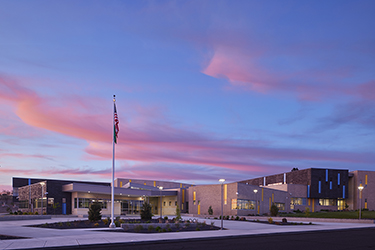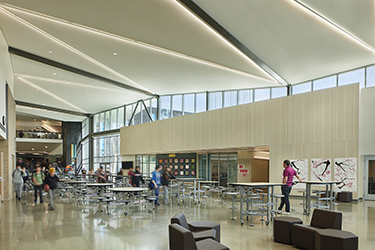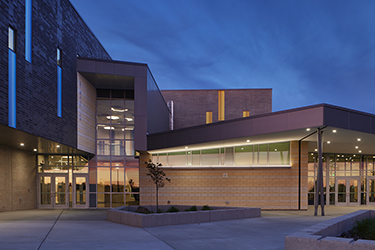|
Subscribe / Renew |
|
|
Contact Us |
|
| ► Subscribe to our Free Weekly Newsletter | |
| home | Welcome, sign in or click here to subscribe. | login |
Architecture & Engineering
| |
 |
March 30, 2023
At Glover Middle School, the lighting runs through it
NAC Engineering

Allen
|
Nestled just north of downtown Spokane, the new Glover Middle School sits where the urban turf begins to disperse into open nature. Visitors to the local Riverside State Park can explore a wide river lined with evergreen trees and climb on boulders that have been carved over centuries.
This site inspired the school’s architecture. A large, open space cuts through its center, in which a faceted ceiling flows and connects to learning neighborhoods. The lighting reinforces this experience, like a river running through a large central canyon as it branches out and gathers in eddies and glides past boulders.
The design concept links learning neighborhoods, including classrooms, to this main, central learning commons, which is directly adjacent to specialized resources and support services. Counselors, administrators, and support staff are located here, at the heart of the school, to invite student engagement as part of their daily routines. The learning commons also opens to the library, making it a visual hub for the school. The lighting design reinforces all these connections and helps to create calming, inspiring environments that support student success — socially, emotionally and academically.
Each classroom is zoned to give instructors control over brightness in many different presentation and teaching scenarios. Lighting controls further meet local codes and provide daylight-responsive dimming. The lighting power density actually conserves an extra 30% beyond the code-determined allowances.
Special classrooms and intervention areas include dynamic color temperature systems as another tool for providing an ideal learning environment. A teacher can shift the color temperature in these spaces from 2,700 degrees Kelvin to 6,500 degrees Kelvin. The lower color temperatures on the spectrum (red) help create a calming, relaxing environment. The higher end of this range (blue) inspires energy and focus. Preset switches in each classroom give instructors the ability to choose five separate preprogrammed points along the spectrum. From there, the controls allow for adjustability along the entire spectrum. This feature, along with full dimming capabilities, means that the lighting environment in each classroom can be tailored to the students’ needs.
Visual comfort needs were also addressed throughout the school. While providing lighting levels required by the Health Department, these bright, welcoming spaces were balanced with indirect lighting and casting light through diffuse materials.
Glover’s lighting design takes maintainability in account, as well, with consideration for district staff who are already stretched thin in their responsibilities. Where lights are in high ceilings, their remote drivers are located in easy-to-reach lower ceiling areas.
Julie Allen is an associate at NAC Engineering.
Other Stories:
- In Edmonds, a park runs through it
- Engineering gets specialized in response to increasing complexity
- Equitable development: nice to have or essential best practice?
- Engineering solutions, as waters rise
- Revitalizing downtowns with office-to-residential conversion
- Structures and sustainability: pursuing net-zero carbon emissions
- Employee ownership for all: an alternative to the ESOP
- New form of team work needed for multifamily projects
- So you want to be a rock star (marketer)
- Natural direction is a new path in architecture





